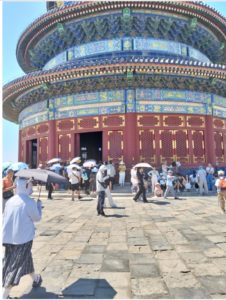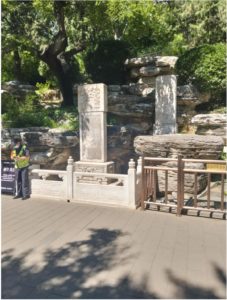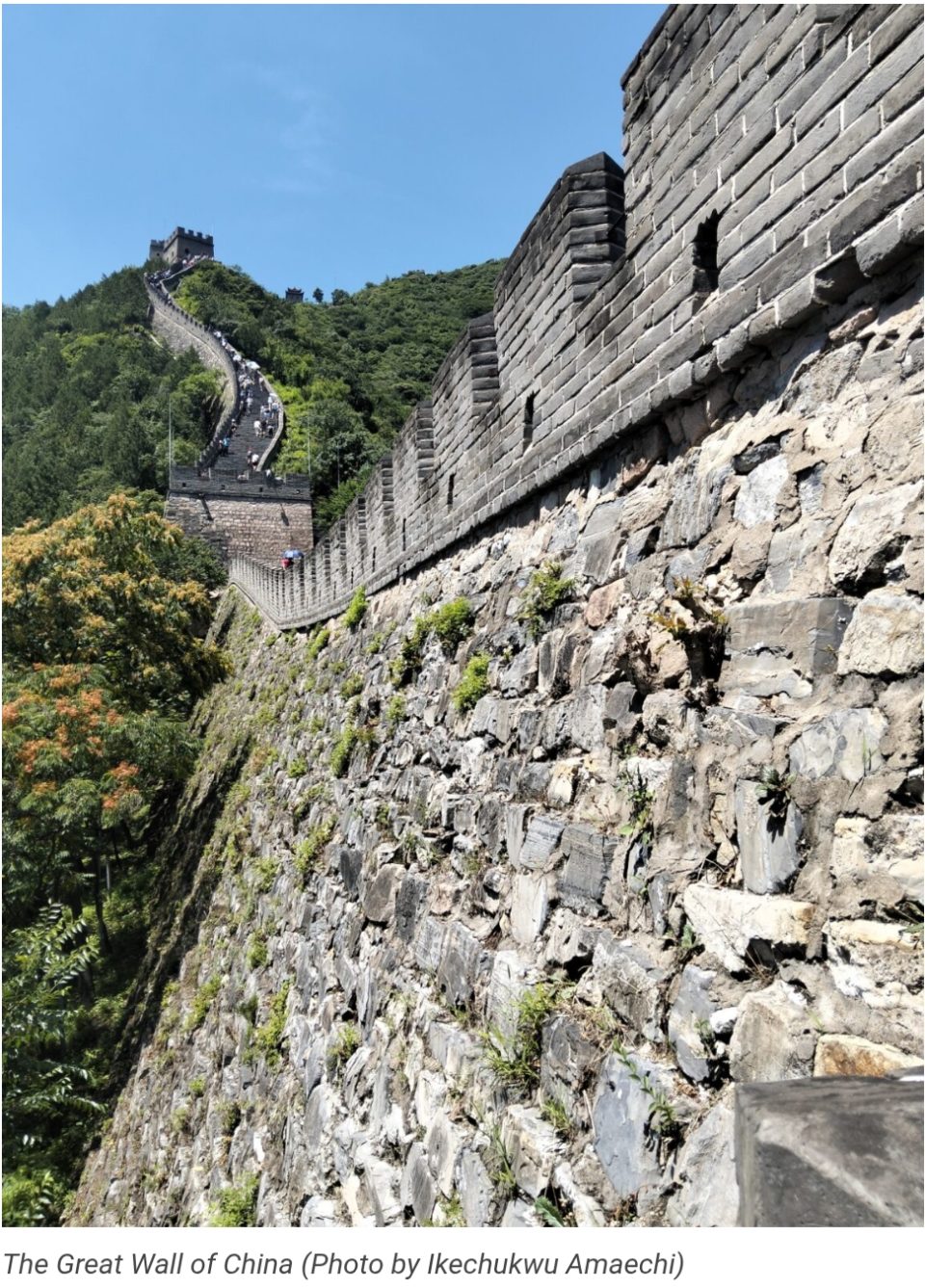China and the magic of tourism: China is developing at a rate that astounds the entire global community and the growth of its economy is breathtaking. But while many attribute this development to its technological breakthroughs, which are, no doubt phenomenal, IKECHUKWU AMAECHI, who is currently in China, courtesy of the Chinese Consulate in Lagos, examines the role played by the tourism industry in this all-inclusive growth. The country, as in every other thing else, is simply upping its game in tourism and the world is, once more, paying attention.
What many people know about China and its 1.412 billion citizens is the unprecedented technological advancement and its strategic position in Artificial Intelligence (AI) industry where it currently accounts for between 25% and 30% of the global AI market estimated at $500-$600 billion in 2024. So, there is no doubting the fact that the country can be described, and rightly so, as technology on steroids. And the implication is that it has become, to the envy of the West, the manufacturing hub of the world.
But what many people, particularly those yet to visit the country, don’t know is the extent to which China is leveraging on its rich cultural heritage powered by technology not only to propel its tourism industry to unfathomable heights but also orchestrate one of the most inclusive economies in the world.
For starters, China has 59 UNESCO heritage sites, only one short of Italy’s 60 sites. Each of these sites has been turned into a money-spinning machine. Right from the time of arrival at the Beijing International Airport and stay at the NOVOTEL Hotels and Resorts, also known as NOVOTEL Peace Beijing, it was apparent that the Chinese were eager to showcase the wonder that the country has become. And they didn’t waste time.
Surprisingly, the showcasing didn’t start with the manufacturing companies or the AI wonderlands. It started with the Tourism industry. And that is understandable. The contribution of tourism to China’s GDP is significant and multifaceted. A 2015 study showed that tourism directly contributed 4.9% to China’s Gross Domestic product. But that is only half of the story. The bigger picture shows that when considering both direct and indirect impacts, such as supply chain and employment effects, the sector’s contribution rose to 10.8% of GDP in the same year.

In terms of revenue, a tourism scholar and archaeologist, Ikenna Emewu, reported in March that “In 2024, China’s economy had 7.3% of the GDP from tourism. In concrete terms, China’s GDP in 2024 was about $19 trillion and the 7.3% tourism content translates to $1.387 trillion.”
The significance of this statistics becomes starker when the fact that the money accruing to the Chinese coffers from tourism alone is more than twice the entire GDP of ECOWAS which stood at $633 billion in 2022 and more than the net income of $121.3 billion that Saudi Aramco reported in 2023 as the earnings of Saudi Arabia, the world’s largest producer of crude oil.
It is, therefore, not surprising that in 2024, tourism employment in China rose to approximately 77.47 million people, accounting for 10.6% of the country’s total employment. The most remarkable thing about the tourism industry in China is that unlike in most other countries, domestic tourism has a larger impact on GDP than inbound tourism with 6.79 trillion RMB in spending, supporting roles in hospitality, transportation and attractions.
So, when it comes to tourism, Chinese people look inwards and with a population of 1.4 billion, the second largest in the world, even without inbound tourists, the country is not complaining. Here, patriotism plays a crucial role here. But even at that, inbound tourism (foreign visitors) is surging post-COVID-19 with 95 million arrivals in the first three quarters of 2024, nearing 90% of the pre-pandemic levels. The implication of this is that it can only get better.
The fact that China’s tourism industry is growing faster than the overall economy is not by happenstance. It is the consequential outcome of a deliberate, technology-driven measures with evolving tech integration, niche tourism services and policy-driven expansions. As the government’s support for cultural tourism magnifies, and it continues to provide magnificent infrastructure, particularly transportation, and the hospitality sector expands with online travel services leading to increase in the volume of trade, tourism will, indubitably continue to play a key role in China’s economy.
With 59 UNESCO heritage sites, China is aggressively marketing itself not only to the outside world but to its citizens.
Great Wall of China
One of the most iconic tourist destinations in Beijing, China’s capital city, is the Great Wall of China, the most famous and well-preserved being the Badaling and Mutianyu sections, which is about 70 kilometres from Beijing. With ticket prices of between 40 and 60 Yuan with around 10 million visitors annually, the about 21,196-kilometre wall which traverses from the North East to the North West of the vast country, is indeed a marvel to behold.
On Thursday, the first day of the tour, the crowd of visitors, most of them young Chinese, was impressive. The tour guide, Zhang Hong, explained that the wall was built over many centuries beginning as early as the 7th century BCE under various dynasties for the purpose of defence. However, the most famous sections according to well-documented research were constructed during Qin Dynasty (221-206 BCE) to defend against northern nomads known as Xiongnu. But it was the Han Dynasty (206 BCE – 220 CE) that expanded the wall westward into the Gobi Desert but the most well-preserved and iconic sections, which were built to defend China against Mongols, was under the Ming Dynasty in the 14th century (1368-1644).
Hong explained that over 400,000 labourers were conscripted by the Emperor to make the bricks used in building the wall under very harsh conditions. Those who could not deliver on time were summarily executed and even those who delivered on time, their life span once they started the job didn’t exceed four months because of the very cruel conditions.
However, the iconic Badaling section of what is the first in the original “Seven Wonders of the World” was rebuilt by the military in the 1980s for the purpose of tourism.
Summer Palace
The Emperors who ruled China were, no doubt men of opulence. But the modern Chinese state has recreated the palaces where the emperors lived or spent their vacation and they have become iconic tourist destinations.
One of the palaces is the Summer Palace in the heart of Beijing which is not only one of China’s most iconic imperial gardens but also a UNESCO World Heritage Site.
Hong explained that the palace was originally built by Emperor Qian Long in 1750 as the Qingyi Garden to celebrate his mother’s birthday. The construction was reportedly done by over 10,000 labourers who worked for 15 years on a 290-hectare of land that included lake and mountains. In fact, the lake which is artificial covers three quarters of the entire space.

The Palace which was destroyed in 1860 during the Second Opium War and later rebuilt in 1888 under Empress Dowager Cixi has the Kunming Lake and longevity Hill, blending natural and artificial landscapes.
Because the Queen Mother was born on July 28 (7/28), the Palace has a 728-metre-long corridor with over 14,000 traditional Chinese paintings. Reputed to be the longest painting corridor in the world, each of the paintings was done by a different artist. Completing the magnificence of the palace is a marble boat, Seventeen-Arch Bridge and Tower of Buddhist Incense.
Incidentally, despite its magnificence, the Emperor never lived there but only used the Palace as a royal retreat for summer relaxation but quickly moved back to the Forbidden City immediately summer was over, hence its name – Summer Palace.
Today, what is a relic of ancient civilisation has been preserved by the Communist Party and over 30,000 tourists flock the palace every day.
Royal Garden
There is also another vast expanse of real estate called Royal Garden. Legend has it that that was the place the Emperor went to in April just to see flowers. Built in 1420 and rebuilt in 1889, the Royal Garden has more than 100,000 ancient cypress trees, most of them more than 500 years old.
Incidentally, it was at the Garden that Zhu Youjian, better known as Emperor Chong Zhen, the last ruler of the Ming Dynasty, who reigned between 1627 and 1644, committed suicide on April 25, 1644 by hanging on Meishan (Coal Hill, now Jingshan Park) behind the Forbidden City.

Temple of Heaven
The temple, a historic religious complex in Beijing, renowned for its magnificent architecture and cultural significance and used by emperors to perform sacred rituals to ensure good harvest and divine blessings, was built in 1420 during the Ming Dynasty.
With key features such as Hall of Prayer for Good Harvests, a striking triple-gabled circular building with a blue-tilted roof, symbolising heaven, a wooden building 36 metres high constructed without nails using intricate wooden joinery; Imperial Vault of Heaven, a smaller circular structure housing ceremonial tablets, surrounded by the Echo Wall where sound travels along the curved surface and a three-tiered marble platform where the emperor prayed for rain and good harvests, the Temple became a UNESCO World heritage Site in 1998 adopted for its architectural harmony and historical importance.
Capital Museum
On Sunday, we were at the Capital Museum, a five-floored magnificent edifice on 2.5 hectares, which was built in 2006 at the cost of 1.2 billion RMB. A plaque on the wall calls it “Eternal witness of civilisation: History of Beijing.” With 120,000 exhibitions, dating back 700,000 years ago, it couldn’t have been anything less.
China has over 5,500 museums making it one of the countries with the highest number of museums globally. But it is not done yet. With an average of between 100 and 200 new museums opening every year since 2010, the ultimate goal is to have more than 6,500 museums by 2035 in accordance to the dictates of the national cultural development plans. In fact there is a museum for everything in China including science and technology, an indication of a country confident with its history, warts and all. In all, Chinese museums are reputed to hold over 20 million artefacts representing the totality of the people’s culture and history, telling stories of a people that claim a very sophisticated civilization dating back aeons. They hold more than 8,000 exhibitions every year attended by an estimated 160 million people. But in all, over 1.5 billion people visit the museums annually.

In the four days that I have been in China, I have been to a theatre to watch an opera, the Lao She Teahouse, a cultural landmark in Beijing named after the renowned Chinese writer Lao She. It is a cultural hub that combines traditional tea culture with performances of Beijing opera – crosstalk, rap-style storytelling and magic shows. While the shows are going on, visitors are offered Dawancha – casual tea served in big bowls.
There is the Panda Zoo where visitors go to see the nine pandas that are said to be living. I only saw two and there is also the Bamboo Park or Zizhuyuan Park.
So, whether it is the Forbidden City, Old City or even Tiananmen Square, almost every piece of the entire Beijing landscape has become a tourist destination actively promoted by the government with the aid of digital technology. And the harvest is plentiful and the Chinese State and its citizens are happier for it. At the rate China is going, it will not only conquer the world digitally sooner than later, that is assuming it has not done so yet, but its cultural voice will also continue to resonate globally.


